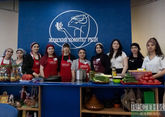The South Caucasus is famous for its natural beauty, fascinating landscapes, but its main wealth is the people who pass down through the generations wisdom and spirituality of the peoples living here. The culture of the inhabitants of the South Caucasus region manifests itself in many phenomena of everyday life. The easiest way to soak up local culture is to enjoy a national cuisine of the region. However, cuisine is not just food, but a system of collective ideas about the food preferences, which represent cultures of the peoples in the region.
Although cuisines of individual places in the region sometimes vary notably from each other, they are based on the same foods and ingredients. Above all, it's meat, which is prepared with special attention. The peoples of the South Caucasus don't usually trust technological advances when cooking meat - the process of cooking the most delicate kebab of lamb or pork requires maximum attention. It is important that the aroma of smoke accompanied the aftertaste of the finished dish.
Another important feature of Caucasian cuisine is the fact that any dishes can be broiled. It does not matter whether it is fried or boiled, the sacrament of its preparation symbolizes hospitality, both on holidays and weekdays. Hospitable hosts demonstrate their hospitality and desire to share the results of their work, because, despite modern urban trends, many representatives of the South Caucasian people do not lose touch with the land and have subsidiary farms. The land here is a source of another indispensable element of any feast - greenery. Greens are needed to prepare any sauce or hot dish. The virtuosity of Armenians, Azerbajanis and Georgians combining any greenery with poultry, fish or vegetables is beyond explanation, since it's often intuitive. And each housewife prepares the dish in her own way, experimenting with certain components.
Caucasian cuisine has long been the hallmark of the region. The mobility of the population, the development of transport routes and communications entailed the exchange of culinary nuances. Barbecue, baking bread, cooking salads and dairy drinks with plants and herbs exist outside the region as well, including among the Turkic-speaking and Arabic-speaking peoples, due to the availability of the necessary ingredients. At the same time, numerous contacts of peoples made it difficult to determine the place of origin of a particular dish, forcing to refer it by title to one or another national cuisine.
Meanwhile, ideas about the people's gastronomic culture are formed in contact with another culture. The need arises to seek common grounds for a sustainable collective existence. Therefore, over time, it became possible to integrate the historical heritage of individual regions of the South Caucasus into a single national tradition, in which gastronomic habits became a factor of rapprochement. As a result, food habits are characterized as something homogeneous and undifferentiated everywhere where this culture exists.
The gastronomic proximity of the South Caucasian peoples offers the prospect of interethnic unity, taking into account such features as abundance, generosity and diversity. Gastronomic culture, above all, demonstrates everyday eating habits. For example, dolma is popular both in the region and beyond. Despite the author's changes in its cooking, which it has undergone over the centuries, its classic recipe is equally in demand in all the republics of the South Caucasus. Moreover, this recipe often acquaints one with the practice of cooking boiled meat. First of all, it's easy to cook it. The popularity of dolma testifies to the inclusion of this dish in the system of current international relations and, thus, confirms its special culinary status. The situation is similar with regard to winemaking. The South Caucasian winemaking heritage is known to those who complement culinary masterpieces with wine and at the same time devotes special attention to its dosage, as the drinking culture is also regulated at the household level.










